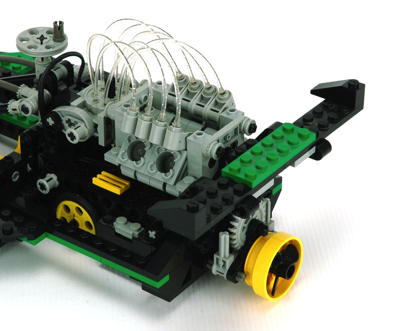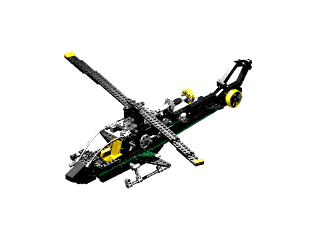1st
Model: Helicopter
|
A helicopter is the "primary" model, or at least the one that uses the
most parts. It is interesting to note that even though this is the
main model it leaves some major parts unused such as the tires and
piston engine parts.
It's single feature is a rotating main rotor with simulated turbine
engine. However, apart from the moving parts, this is among the
best looking Technic helicopters which is saying something given how
many there have been. I think it looks like a Bell Jet
Ranger. The canopy is made convincingly from flex hoses.
|
 
Click
to download the LDraw
file of this model.
Model by Dlarian
|
|
Engine
The main rotor is rotated by a crank on the side through some bevel
gears at 1:1. A second set of bevel gears drives the fiber optic
element at the same ratio. The fiber optics surround the rear of
the turbine, and while the lights move, none of the simulated engine parts move.
|


Click for an animation of
the engine in motion.
|
2nd
Model: Boat
|
The second model is a Cylon Raider
hydroplane racing boat, and despite being a bit bulky looks very much
like one. The outboard sponsons and rear wing look excellent, and
the propeller is geared to some hidden wheels. This is the only model with multiple geared functions.
|

|
|
Engine
The V-4 engine is driven by some wheels hidden under the hull and also
geared to the propeller which spins as the boat moves. The fiber
optic elements seem to represent spark plug wires, but curiously there
are 8 of them. I suppose a racing engine may have 2 plugs per cylinder.
|

Click for an animation of
the engine in motion. |
|
Hatch
The driver's access hatch can be opened via a worm driven crank on the
roof. The hatch itself is made from axles and flex hoses.
|

Click for an animation of
the hatch in motion. |
3rd
Model: Drag Racer
|
The
third model is an American style drag racer with steam
rollers on the back and pizza cutters on the front. There were
enough parts left over in this model that the instructions also include a
start/finish gate, although actually driving a top fuel dragster
through such a gate would be disaster.
|

|
|
Engine
The V-4 engine is driven by a single rear wheel (no
differential). Obviously this should be a V-8, but given the size
of the model this seems appropriate. The fiber optic
elements are routed in such a way that they really can't be spark plug
wires because they terminate all over the place. Perhaps they
represent the flames shooting from the exhaust manifolds.
|
|
4th
Model: Robot
|
The
4th model is a mono-wheeled robot. This was long before the
Segway, so perhaps this model represents some prescient prognostication
on the part of the designer. In any case, since the model is
totally unpowered it does not balance itself and I had to build a tail in back to hold it up for photography.
When building the model I was expecting the arms to be geared to
the wheel, but they are not. They are fixed but pose-able.
|

|
|
Brain
The positronic brain of this robot (or android) seems to have some
exposed synapses firing. The fiber optic element is driven by the
single main wheel.
This animation is particularly lame, so I won't be offended if you skip it.
|

Click for an animation of
the robot in motion. |
| 5th
Model: Bug |
The
final model is an insect with a bulbous thorax and abdomen. Like
the robot, the fiber optics seem to represent the brain, but the wings
also flap. The legs are supported at an angle by toothed
connectors under considerable bending stress.
|

|
|
Wings
A crank at the rear of the abdomen powers a cam system which oscillates
to flap the wings in time with the rotation of the fiber optic
element. It works very well and makes this one of the more
innovative models in the set.
|

Click for an animation of
the wings in motion. |















